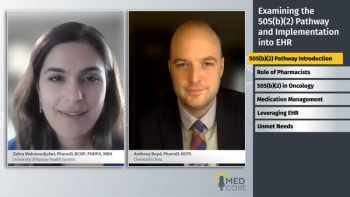
Zahra Mahmoudjafari, PharmD, MBA, BCOP, FHOPA
Articles by Zahra Mahmoudjafari, PharmD, MBA, BCOP, FHOPA


August marks a pivotal time for oncology pharmacy, blending transitions, celebrations, and new beginnings as professionals prepare for the upcoming season.

Panelists discuss how advancing chronic graft-vs-host disease (cGVHD) management involves improving steroid response rates, exploring combination therapies, utilizing biomarkers for personalized treatment, and striving for steroid-free first-line options to enhance patient outcomes and reduce long-term adverse effects.

Panelists discuss how collaboration between pharmacists and health care providers is essential for optimizing treatment outcomes in chronic graft-vs-host disease (cGVHD), emphasizing the importance of education, symptom management, and a multidisciplinary approach to ensure comprehensive, patient-tailored care.


Zahra Mahmoudjafari, PharmD, MBA, BCOP, FHOPA, co-chair of the 2025 Oncology Pharmacists Connect (OPC) meeting, discusses what makes the event unique, highlights key sessions, and shares her excitement for the educational and networking opportunities.

Panelists discuss how pharmacists improve patient outcomes in chronic graft-vs-host disease (cGVHD) by addressing accessibility and tolerability challenges, optimizing drug regimens, managing adherence, and fostering trust with patients to ensure consistent therapy and long-term success.

Panelists discuss how pharmacists are essential in managing chronic graft-vs-host disease (cGVHD) by addressing challenges like toxicity, financial and logistical barriers, and a lack of awareness, while advocating for patient education, collaboration with health care teams, and ensuring access to necessary therapies.

Panelists discuss how evolving treatment pathways at Emory Healthcare, including earlier use of emerging therapies and off-label combination treatments, are shaping the management of chronic graft-vs-host disease (cGVHD), with an emphasis on personalizing therapy based on real-world data and patient-specific factors.

Panelists discuss how factors such as patient preferences, disease severity, organ-specific involvement, and adverse effect profiles influence the selection of second-line therapies for steroid-refractory chronic graft-vs-host disease (cGVHD) in the context of multiple FDA-approved agents.

Panelists discuss how factors such as patient preferences, disease severity, organ-specific involvement, and adverse effect profiles influence the selection of second-line therapies for steroid-refractory chronic graft-vs-host disease (cGVHD) in the context of multiple FDA-approved agents.

Panelists discuss how recent FDA approvals and evolving evidence for second-line treatments, including ruxolitinib, ibrutinib, and belumosudil, are reshaping chronic graft-vs-host disease (cGVHD) management by offering tailored, evidence-based options for steroid-refractory patients.

Panelists discuss how second-line therapy selection and individualized care strategies are essential in chronic graft-vs-host disease (cGVHD) management, emphasizing the need to reduce steroid-related toxicity, address patient-specific factors, and leverage pharmacist expertise to optimize outcomes.

Panelists discuss how early diagnosis, evolving treatment strategies, and pharmacist-led interventions are advancing chronic graft-vs-host disease (cGVHD) management by addressing unmet needs, improving care coordination, and enhancing patient access to emerging therapies.

Zahra Mahmoudjafari, PharmD, BCOP, FHOPA, shared insight from the HOPA Annual Meeting 2025.

Metrics should empower pharmacists rather than burden them.

Pharmacists are essential navigators in the complex landscape of gene therapy.

A panelist discusses how the 505(b)(2) regulatory pathway provides a streamlined approval process for modified versions of previously approved drugs, allowing pharmaceutical companies to rely partly on existing safety/efficacy data while still requiring new clinical data, commonly used across various therapeutic areas including reformulations, new dosage forms, and drug combinations.


Pharmacists bring a unique perspective to health care that bridges clinical knowledge, patient-centered care, and operational expertise.

The panel discussion concludes with final thoughts on the future landscape of newly diagnosed multiple myeloma.

Panelists discuss how pharmacists can address remaining unmet needs and challenges in optimizing frontline therapy for patients with transplant-eligible newly diagnosed multiple myeloma (NDMM), including areas such as managing complex drug interactions, improving medication adherence, mitigating treatment-related toxicities, streamlining transitions of care, and enhancing patient education and support throughout the treatment journey.

Panelists discuss how they navigate challenges with payer coverage for quadruplet regimens in multiple myeloma treatment, including strategies they employ to address insurance denials or restrictions, such as providing clinical justification, leveraging recent trial data, and collaborating with financial assistance programs to ensure patients can access optimal therapy despite potential coverage difficulties.

Panelists discuss how treatment regimens for multiple myeloma patients can be personalized to improve adherence and quality of life by considering factors such as dosing schedules and routes of administration while emphasizing the role of pharmacists in providing resources and support to keep patients informed, engaged, and compliant with their individualized treatment plans.

Panelists discuss how pharmacists actively engage in educating and coordinating with nurses, oncologists, and other health care providers by conducting in-service trainings, participating in multidisciplinary team meetings, and collaborating on the development and implementation of formularies, order sets, and treatment protocols to ensure optimal patient care in multiple myeloma management.

Panelists discuss how pharmacists play a crucial role throughout the multiple myeloma patient journey, from diagnosis to treatment, by contributing to medication management, patient education, adverse effect monitoring, and the development and implementation of order sets and clinical pathways within electronic medical record systems, thereby enhancing treatment efficacy and patient safety.

Panelists discuss how subcutaneous (SC) administration of drugs like daratumumab offers advantages over intravenous (IV) administration in terms of reduced health care resource utilization, improved patient convenience, and potentially better treatment adherence, while also considering potential drawbacks such as injection site reactions and the need for proper training in SC administration techniques.

Panelists discuss how the FDA approval of daratumumab and hyaluronidase-fihj combined with VRd (bortezomib, lenalidomide, and dexamethasone) for induction and consolidation in transplant-eligible newly diagnosed multiple myeloma patients is changing treatment approaches while also considering how recent evidence suggesting reduced observation time for subcutaneous (SC) daratumumab administration may streamline patient care and improve treatment efficiency.

Panelists discuss how recent phase 3 trial data from PERSEUS, IsKia, and GMMG HD7 are shaping their approach to induction and consolidation therapy in transplant-eligible newly diagnosed multiple myeloma (NDMM) patients, particularly focusing on the incorporation of CD38 antibodies into upfront treatment regimens and the potential shift from triplet to quadruplet therapies based on these pivotal trial findings.

Panelists discuss how implementing novel combination therapies or emerging agents from clinical trials into real-world clinical practice for multiple myeloma faces significant challenges, including managing complex dosing regimens, addressing potential toxicities, ensuring patient adherence, navigating insurance coverage and cost issues, and bridging the gap between highly controlled trial conditions and diverse patient populations encountered in everyday clinical settings
Latest Updated Articles
 Emerging Data: Impacts of ROCKstar and AGAVE-201
Emerging Data: Impacts of ROCKstar and AGAVE-201Published: May 30th 2025 | Updated: June 5th 2025
 Pharmacists at the Forefront: The Evolving Landscape of Bispecific Antibodies in Cancer Care
Pharmacists at the Forefront: The Evolving Landscape of Bispecific Antibodies in Cancer CarePublished: October 15th 2024 | Updated:
 Pharmacist-Led Interventions for Adherence and Optimization
Pharmacist-Led Interventions for Adherence and OptimizationPublished: June 13th 2025 | Updated: June 5th 2025
 Multidisciplinary Collaboration in cGVHD Care
Multidisciplinary Collaboration in cGVHD CarePublished: June 20th 2025 | Updated:
 Overcoming Barriers to Access and Treatment
Overcoming Barriers to Access and TreatmentPublished: June 13th 2025 | Updated: June 5th 2025
 Sequencing Strategies and the Role of Combination Therapy
Sequencing Strategies and the Role of Combination TherapyPublished: June 6th 2025 | Updated: June 5th 2025






